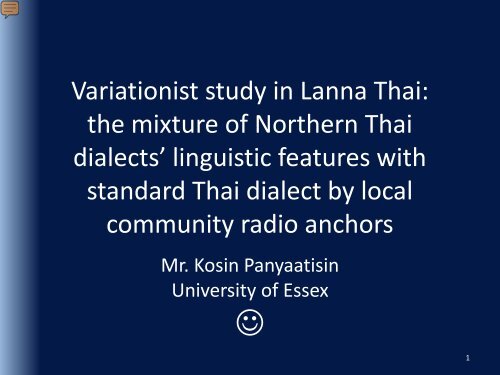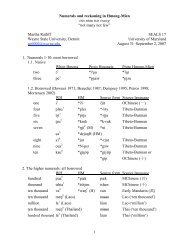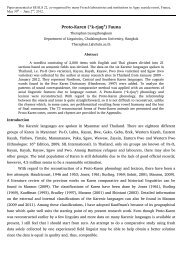Code mixing in Lanna Thai: the mixture of Northern Thai dialects ...
Code mixing in Lanna Thai: the mixture of Northern Thai dialects ...
Code mixing in Lanna Thai: the mixture of Northern Thai dialects ...
- No tags were found...
Create successful ePaper yourself
Turn your PDF publications into a flip-book with our unique Google optimized e-Paper software.
1. Introduction<strong>Lanna</strong> <strong>Thai</strong> (NT) and its l<strong>in</strong>guistic diversity• <strong>Lanna</strong>, a former k<strong>in</strong>gdom for at least 700 years.• Compris<strong>in</strong>g various ethnic groups.• Accord<strong>in</strong>g to <strong>the</strong> monol<strong>in</strong>gual policy <strong>in</strong> K<strong>in</strong>g Rama 6 th period<strong>in</strong> 1921 and <strong>the</strong> state decree <strong>in</strong> 1939 by Field MarshalPibulsonggram, attrition <strong>of</strong> many regional <strong>dialects</strong> started toappear.• Standard <strong>Thai</strong> dialect are widely used and mixed by <strong>the</strong>younger NT generation speakers.• We will focus on <strong>the</strong> l<strong>in</strong>guistic situation and <strong>the</strong> variation <strong>of</strong>two major <strong>dialects</strong> <strong>in</strong> this <strong>Lanna</strong> or Nor<strong>the</strong>rn <strong>Thai</strong> <strong>dialects</strong>(NT): Yong <strong>of</strong> Lamphun prov<strong>in</strong>ce and (Kam)Muang <strong>of</strong> ChiangMai prov<strong>in</strong>ce taken from conservative local radio anchors.2
Yong vs. Muang vs. BKK <strong>Thai</strong> dialectThese <strong>dialects</strong> belongs to Tai-Kadai family, Southwestern <strong>Thai</strong>,East Central groupLanguagefamily and itssub-groupMost found(Salient)Yong (Kam)Muang BKK <strong>Thai</strong>Northwest , Lue group Chiang Saeng, Yuan? Chiang Saeng orBKK <strong>Thai</strong>NT prov<strong>in</strong>ces, LamphunNT prov<strong>in</strong>ces, ChiangMaiCluster 2 2(<strong>the</strong> same as Yong)Diphthong Not found 6(short and long ones)Tone 6 6 (different fromYong)SomeConditions <strong>of</strong>vowelsSome sets <strong>of</strong> vowels can be <strong>in</strong>complementary distributionwith Muang dialect’s vowelsN/AProv<strong>in</strong>ces <strong>in</strong> <strong>the</strong>Central part,Bangkok116 (<strong>in</strong>clud<strong>in</strong>gMuang dialect)5N/A5
3. Objectives <strong>of</strong> <strong>the</strong> study1) To <strong>in</strong>vestigate <strong>the</strong> distribution <strong>of</strong> <strong>the</strong> variation<strong>of</strong> (r), (Cr) and (negators) across three socialvariables based on <strong>the</strong> radio anchors:[1] Ethnicity by geographical orig<strong>in</strong>s[2] Gender[3] Type <strong>of</strong> <strong>the</strong> contexts/formality.2) To compare <strong>the</strong> correlation across variousl<strong>in</strong>guistic variables (<strong>the</strong>ir variants) with socialvariables (<strong>the</strong>ir sub-social variables) <strong>in</strong> orderto f<strong>in</strong>d <strong>the</strong> leader <strong>of</strong> <strong>the</strong> l<strong>in</strong>guistic change.8
L<strong>in</strong>guistic/ Dependent variables1) (r) = [r-1], [l], [h][r-1] <strong>in</strong>cluded alveolar trilled [r] and tapped () present<strong>in</strong>g <strong>the</strong>prestige variants <strong>of</strong> BKK <strong>Thai</strong>.2) (Cr) = [Cr], [Cl], [C]3) (negators) = [bor], [mai]9
Yong vs. Muang vs. Bangkok <strong>Thai</strong>’s phonology(Categorically)Yong Maung BKK <strong>Thai</strong>/r/ /l/ /h/ (In fact, it does exist <strong>in</strong> BKK<strong>Thai</strong> but it is not found <strong>in</strong> thiscondition)/Cr/ /Cl/ /C/ mai bor (*only found <strong>in</strong> <strong>the</strong> literaryand <strong>Thai</strong> literatures) also, ‘mi’,‘paj’ and ‘hon’ (Pittayaporn etal., 2011) 10
Social/ Independent variables1) Ethnicity by geographical orig<strong>in</strong>- Yong (NT-Lamphun prov<strong>in</strong>ce)- Muang (NT-Cha<strong>in</strong>g Mai prov<strong>in</strong>ce)2) Gender- Male- Female3) Types <strong>of</strong> contexts/ Formality:- Formal context- Informal context11
4. Hypo<strong>the</strong>ses(on <strong>the</strong> social factor basis)1. Ethnicity by geographical orig<strong>in</strong>:Yong might use [r-1] and [Cr] and [mai] more than Muang.2. Gender:Female might use [r-1] and [Cr] and [mai] more than Male.3. Type <strong>of</strong> context/ Formality:In <strong>the</strong> formal context, [r-1] and [Cr] and [mai] might beemployed more than <strong>in</strong>formal context.4. Multivariate analysis and <strong>the</strong> leader <strong>of</strong> change:Female, Yong, <strong>in</strong> <strong>the</strong> formal context, might become a leader<strong>of</strong> a l<strong>in</strong>guistic change (to conform <strong>the</strong>ir vernaculars to BKK<strong>Thai</strong> dialect phonological and grammatical system).12
5. Reviews• Literatures and related works• Labov (2001; 2006)• Trudgill (1986)• Chamber (2003)• Bebee (1974)• Bell (1997)• Pittayaporn et al. (2011)• Macaulay (2005)• Etc.13
6. Methodology• Data: Connected speeches, around 10-15 m<strong>in</strong>sper speaker• Participants: 2 ethnicities X 2 genders X 2 types<strong>of</strong> <strong>the</strong> context = 8 people• Source <strong>of</strong> data: digitally recorded from <strong>in</strong>ternetradio and local radio channels (FM) claimed to beYong people from Lamphun prov<strong>in</strong>ce and Muangpeople from Chiang Mai prov<strong>in</strong>ce• Age: over 35 years old14
Examples from <strong>the</strong> anchors' speechEx.1 Kongkoi ghost-<strong>in</strong>วิ่งเร็วขนาดไหน มันก็บ่ตันย่าผีกองกอยwi rew khanat nai man k: b tan a: phi: kok“No matter how fast he could run, he cannot run asfast as <strong>the</strong> Kongkoi ghost.”Ex. 2 Yong-Ineloquent hungry-Inเพง อยากเป็ นคนฮักบ่อยากเป็ นจู๊phe ak pen khon hak b ak pen cu:“With a song, (I) want to be your lover, not yoursecret lover/ mistress.”15
Examples from <strong>the</strong> anchors’ speechEx.3 Phra Inthorn-Forเอาจ๋นเดือดร้ อน ฮ้อน*ไหม้aw con dt ron hon* mai“Make yourself <strong>in</strong> trouble a great deal.”Ex.4 Yong-smoked orange-Forยับยั ้งเซลล์มะเล็งและเลื่องของโลคเบาหวานapa sel ma le l la kho lok bawan“To restra<strong>in</strong> <strong>the</strong> cancer cells spread<strong>in</strong>g, anddiabetes.”16
Statistics and analyses1) Raw score & Percentage (%)2) Mak<strong>in</strong>g a corpus: per 1,000 words and<strong>the</strong>ir total wordcounts (Macaulay, 2005)3) Chi-square test (correlation andsignificant different) through R-forStatistics17
Wordcount <strong>in</strong> <strong>the</strong> corpustotal = 17,864 wordsSocial factor Sub-social factor Total word countsEthnicityGenderFormalityYong 9,463Maung 8,398Male 7,165Female 10,695Formal 9,069Informal 8,76518
7.F<strong>in</strong>d<strong>in</strong>gs19
Raw scorecodeMuangYongFemale Male Male FemaleFormal Informal Formal Informal Formal Informal Formal Informalvariables(r)(Cr)(negator)raw scoresFemale-WaterconferenceKongkoighostPhrayaTilokarajaMale-KalamasutraPhra InthornYong-IneloquenthungryYongsmokedorange[r-1] 15 29 0 5 9 0 43 33[l] 21 18 43 16 44 16 62 56[h] 35 6 20 39 53 17 19 16sum 71 53 63 60 106 33 124 105[Cr] 24 23 0 12 6 1 7 13[Cl] 5 7 1 4 0 0 14 6[C] 47 12 54 50 25 31 5 16sum 76 42 55 66 31 32 26 35[bor] 5 34 15 25 24 12 7 4[mai] 0 0 0 0 0 0 9 0sum 5 34 15 25 24 12 16 4Yongsuperads20
codePercentage (%)MuangYongMale Female Male FemaleFormal Informal Formal Informal Formal Informal Formal InformalPhraya TilokarajaMale-KalamasutraFemale-WaterconferenceKongkoi ghost[r-1] 0 8.33 21.12 54.71 8.49 0 34.67 31.42Phra InthornYong-IneloquenthungryYong-smokedorangeYong-superads[l] 68.25 26.66 29.57 33.96 41.5 48.48 50 53.33[h] 31.74 65 49.29 11.32 50 51.51 15.32 15.23[Cr] 0 18.18 31.57 54.76 19.35 3.12 26.92 37.14[Cl] 1.81 6.06 6.57 16.66 0 0 53.84 17.14[C] 98.18 75.75 61.84 28.57 80.64 96.87 19.23 45.71[bor] 100 100 100 100 100 100 43.75 100[mai] 0 0 0 0 0 0 56.25 021
codeword counts (sum =17,861)Per 1,000 wordsMuangYongMale Female Male FemaleFormal Informal Formal Informal Formal Informal Formal Informal1,719 1,744 1,863 3,072 2,784 918 2,730 3,031Approx. Time (m<strong>in</strong>s) 10 10 9 16.3 16 7 16 14PhrayaTilokarajaMale-KalamasutraFemale-WaterconferenceKongkoighostPhra InthornYong-Ineloquenthungry[r-1] 0 2.9 8.1 9.5 3.2 0 15.8 10.9[l] 25 9.2 11.3 5.9 15.8 17.4 22.7 18.5[h] 11.6 22.4 18.8 2 19 18.5 7 5.3[Cr] 0 6.9 12.9 7.5 2.2 1.1 2.6 4.3[Cl] 0.6 2.3 2.7 2.3 0 0 5.1 2[C] 31.4 28.7 25.2 3.9 9 33.8 1.8 5.3[bor] 8.7 14.3 2.7 11.1 8.6 13.1 2.6 1.3[mai] 0 0 0 0 0 0 3.3 0Yong-smokedorangeYongsuperads22
Some glances• The [r-1] and [l] found a great deal.• Lots <strong>of</strong> [C] are used (negotiated form).• The [Cl] is less used, and surpris<strong>in</strong>gly [Cr] isheavily used.23
Chi-square test: EthnicitySocial variablesEthnicityVariants Yong VS. Muang Chi-square test[r-1] > [l] > [h] NOT SIG [Cr] < [Cl] NOT SIG [C] < [bor] < X-squared = 5.4211, df =1, p-value = 0.0199X-squared = 14.3774, df= 1, p-value = 0.0001496X-squared = 0.1868, df =1, p-value = 0.6656X-squared = 15.1505, df= 1, p-value = 9.927e-05X-squared = 0, df = 1, p-value = 1X-squared = 40.6572, df= 1, p-value = 1.814e-10X-squared = 12.8442, df= 1, p-value = 0.0003385[mai] > X-squared = 6.2075, df =1, p-value = 0.0127224
Chi-square test: GenderSocial variablesGenderVariants Male VS. Female Chi-square test[r-1] < [l] NOT SIG [h] > X-squared = 6.2075, df =1, p-value = 0.01272X-squared = 0.8958, df =1, p-value = 0.3439X-squared = 42.8576, df= 1, p-value = 5.887e-11[Cr] < [Cl] < [C] > [bor] > [mai]< X-squared = 10.8442, df= 1, p-value = 0.000991X-squared = 9.8036, df =1, p-value = 0.001742X-squared = 68.1884, df= 1, p-value < 2.2e-16X-squared = 18.8042, df= 1, p-value = 1.448e-05X-squared = 4.4729, df =1, p-value = 0.0344425
Chi-square test: Type <strong>of</strong> contextSocial variablesType <strong>of</strong> contextsVariants Formal VS. Informal Chi-square test[r-1] NOT SIG [l] > [h] > [Cr] NOT SIG [Cl] NOT SIG [C] NOT SIG [bor] > X-squared = 0.0121, df =1, p-value = 0.9125X-squared = 12.1237, df= 1, p-value =0.0004978X-squared = 9.5511, df =1, p-value = 0.001998X-squared = 1.7974, df =1, p-value = 0.18X-squared = 0.0504, df =1, p-value = 0.8223X-squared = 1.174, df =1, p-value = 0.2786X-squared = 5.7295, df =1, p-value = 0.01668[mai] > X-squared = 6.8388, df =1, p-value = 0.0089226
Multivariate analysisEthnicityYong Muang not SIG[r-1] [Cr] [h][l] [C [Cl][mai][bor]GenderFemale Male not SIG[r-1] [h] [l][Cr][C[Cl][bor][mai]Type <strong>of</strong> Context/ formalityFormal Informal not SIG[l][h][bor][mai][r-1][Cr][Cl][C27
Summary <strong>of</strong> <strong>the</strong> multivariate analysisConform<strong>in</strong>g to BKK<strong>Thai</strong> dialect Gender Type <strong>of</strong> <strong>the</strong> context Ethnicity[r-1][Cr] female formal Yong[Cl][mai]all requirementfound only [mai]and lack <strong>of</strong> <strong>the</strong> restmost required onesfound but lack<strong>in</strong>g <strong>of</strong>[Cr] plus [l]Conform to Yongand Muang dialect Gender Type <strong>of</strong> <strong>the</strong> context Ethnicity[h] male formal Muang[bor]all requirement plus[Call plus extra [l], [h]and [mai][mai] could be deleted s<strong>in</strong>ce itis <strong>the</strong> subset <strong>of</strong> male?have [bor] but lack<strong>of</strong> [h]Negotiated/defaultforms found almostthree <strong>dialects</strong>[l],[C28
F<strong>in</strong>d<strong>in</strong>gs by social factors1) Ethnicity by geographical orig<strong>in</strong>:Yong might use [r-1] and [Cr] and [Mai] more than Muang.ANSWER: (Partially correct. Yong is found to use less [Cr] andplus [l].)2) Gender:Female might use [r-1] and [Cr] and [Mai] more than Male.ANSWER: (Correct. Females use all <strong>of</strong> <strong>the</strong>m and plus [Cl].)3) Type <strong>of</strong> context/ Formality: In formal contexts, [r-1] and [Cr] and[mai] might be employed more than <strong>in</strong> <strong>in</strong>formal contexts.ANSWER: (Partially correct, merely [mai] are found <strong>in</strong> formalcontexts more than <strong>the</strong> <strong>in</strong>formal ones.29
F<strong>in</strong>d<strong>in</strong>gs by social factors (Cont.)4) Multivariate analysis and <strong>the</strong> leader <strong>of</strong> change:4.1) ANSWER: partially correct. Female, Yong, (only [mai] <strong>in</strong><strong>the</strong> formal context – outlier?), might become a leader <strong>of</strong> thisfocused l<strong>in</strong>guistic change <strong>in</strong> terms <strong>of</strong> conform<strong>in</strong>g <strong>the</strong>irvernaculars to BKK <strong>Thai</strong> by referr<strong>in</strong>g to [r], [Cr] and [mai]variants as <strong>the</strong> markers <strong>of</strong> BKK <strong>Thai</strong>.4.2) Male <strong>in</strong> both groups are more categorical when we referto [h] and bor variants.30
O<strong>the</strong>r F<strong>in</strong>d<strong>in</strong>gs5) [l] is found a great deal. This results might come fromthat NT <strong>dialects</strong> hav<strong>in</strong>g borrowed many novel conceptsform BKK <strong>Thai</strong> dialect. NTs convert <strong>the</strong>se new concepts <strong>of</strong>/r/ <strong>of</strong> BKK <strong>Thai</strong> tokens <strong>in</strong>to /l or h/ <strong>of</strong> NT <strong>dialects</strong>.(BKK <strong>Thai</strong> features are localised by NT speakers.)6) Negator bor is still <strong>the</strong> categorical form used by <strong>the</strong> NTpeople and mai is still performed by <strong>the</strong> outlier (femaleyong-formal).7) Relation between <strong>the</strong> [r] and [Cr]: we might assumethat [r] and [Cr] have a correlation <strong>in</strong> females.31
O<strong>the</strong>r F<strong>in</strong>d<strong>in</strong>gs (cont.)8) In most formal contexts, both <strong>dialects</strong> seemto conserve most <strong>of</strong> <strong>the</strong>ir l<strong>in</strong>guistic features(once we excluded <strong>the</strong> oddball).From anoutlier!?!32
8. Discussion1) Female as a leader <strong>of</strong> l<strong>in</strong>guistic change1.1) Females might treat language as <strong>the</strong> fashion, use <strong>the</strong>new and more prestige forms and are sensitive to <strong>the</strong>stigmatised forms as <strong>the</strong> gender’s paradox (Labov, 2001: 292-3). Thus <strong>the</strong>y are <strong>the</strong> leader <strong>of</strong> l<strong>in</strong>guistic change.1.2) Female anchors become more mixed and moreconcerned about <strong>the</strong> audiences <strong>of</strong> radio broadcast than that<strong>of</strong> males. They are more aware <strong>of</strong> be<strong>in</strong>g broadcasted andmake it becomes mutual <strong>in</strong>telligible. They mixed <strong>the</strong>ir NT<strong>dialects</strong> with BKK <strong>Thai</strong> dialect a lot. Thus, this might be <strong>in</strong>accordance with <strong>the</strong> <strong>the</strong>ories <strong>of</strong> l<strong>in</strong>guistic accommodation(Trudgill, 1986) and/or audience-design model <strong>of</strong> styleshift<strong>in</strong>g (Bell, 1997). 33
1) Female as a leader (Cont.)1.3) Hyper correction usages (Labov, 1972:126)are found.- Quantitatively, 26.19%, [r] for (r): tapped [] toprolonged trilled [r*]- Qualitatively, [r] trilled for (l) (not focusedhere).34
Qualitative Hypercorrection (l) to [r]*Ex. 5 Kongkoi ghost-<strong>in</strong>Ex. 6 Yong-smoked orange-Forยืนเปรือย*กายnan pra* kai“To stand naked”ด้วยความอารัย*รักduaj khwam : rai* rak“to grief over <strong>the</strong> loss <strong>of</strong> someone”ปรอด*จากมะเล็งนี่ มะเล็งนี่เฮาpr:t* cak ma le ni: ma le ni: haw“To be free from cancer, we should …” 35
2) Males are more conservative orreta<strong>in</strong> covert prestige forms[h], [bor]more conservative, more categorical use andmore covert prestige realisation (Labov, 2001)36
3) Dialect contact: <strong>mix<strong>in</strong>g</strong>?3.1) Only (r) distribution <strong>of</strong> Yong NT changes toBKK <strong>Thai</strong> more than Muang’s counterpart bylook<strong>in</strong>g at [r]’s distribution which is found a lot.(NT conforms to BKK <strong>Thai</strong>?).3.2) [Cl] <strong>of</strong> (Cr) is rarely used. It might be <strong>in</strong> <strong>the</strong>process <strong>of</strong> borrow<strong>in</strong>g <strong>in</strong> NT ra<strong>the</strong>r than passthrough <strong>the</strong> same process <strong>of</strong> change like [l] <strong>in</strong> (r)<strong>in</strong> BKK <strong>Thai</strong>. (NT does not conform to BKK <strong>Thai</strong>?).37
Po<strong>in</strong>ts to ponder from (3.1) & (3.2)Thus, <strong>the</strong> system <strong>of</strong> (r) <strong>of</strong> [r-1] and (Cr) <strong>of</strong> [Cl]distribution across multi-social variables are stillfuzzy and contradict each o<strong>the</strong>r - it seem to bemixed. We need to test more about how NT <strong>dialects</strong>are chang<strong>in</strong>g.Emergence <strong>of</strong> a new dialect formation?(As a Ko<strong>in</strong>e? Test children –next research! )OrConvergence <strong>of</strong> NT <strong>dialects</strong> to BKK <strong>Thai</strong>?(As a Dialect levell<strong>in</strong>g? Test adults)38
4) Negators behave differently, us<strong>in</strong>g by moreconscious, ‘bor’ is very strong.• [bor] is very consistently used by NT people.• [mai] is only found <strong>in</strong> an outlier who might perform <strong>in</strong>accordance with <strong>the</strong> BKK <strong>Thai</strong> dialect.• Thus, <strong>the</strong> characteristic and <strong>the</strong> distribution <strong>of</strong>variation <strong>of</strong> negators are different from phonologicalfeatures. They might be employed by dur<strong>in</strong>g moreconscious ra<strong>the</strong>r than less conscious speech, likephonological features.• Grammatical variables, have traditionally been viewedas features which mark social differences moredramatically than phonological ones. (Chambers 2003:57 cited <strong>in</strong> Tagliamote, 2005: 205).39
9. Conclusions1) Female -Yong might become a leader <strong>of</strong> l<strong>in</strong>guistic change toadapt to BKK <strong>Thai</strong> dialect. They perform hypercorrection <strong>in</strong>both ways.2) Males are more conservative.3) At some po<strong>in</strong>t, <strong>the</strong> system <strong>of</strong> (r) <strong>of</strong> [r-1] (conform to BKK)and (Cr) <strong>of</strong> [Cl] (reject BKK) distribution across multi-socialvariables contradict each o<strong>the</strong>r. It seem to be mixed. it mightbe <strong>the</strong> o<strong>the</strong>r process as ei<strong>the</strong>r ko<strong>in</strong>eization or dialectlevell<strong>in</strong>g.4) Negator, [bor] is still <strong>the</strong> categorical form used by <strong>the</strong> NTpeople <strong>in</strong> general and [mai] is merely performed by <strong>the</strong>outlier. This might be because grammatical categories mightbe determ<strong>in</strong>ed or selected to performed more consciouslyra<strong>the</strong>r than phonological features.40
Special Thanks • Pr<strong>of</strong>. Dr. Peter L. Patrick, University <strong>of</strong> Essex, <strong>the</strong> UK(supervisor)• Pr<strong>of</strong>. Emeritus. Dr. Amara Prasithraths<strong>in</strong>t,Chulalongkorn University, <strong>Thai</strong>land (mentor)• Dr. Penchan Kriengkrisuk and Shaun Aust<strong>in</strong>• The SEALS 23 rd ’s travel grant <strong>of</strong>fer<strong>in</strong>g fromChulalongkorn University for ASEANS membersThat’s cool!You know.41





